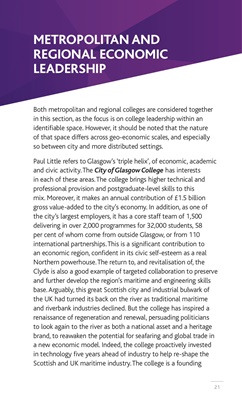
21
METROPOLITAN AND
REGIONAL ECONOMIC
LEADERSHIP
Both metropolitan and regional colleges are considered together
in this section, as the focus is on college leadership within an
identifiable space. However, it should be noted that the nature
of that space differs across geo-economic scales, and especially
so between city and more distributed settings.
Paul Little refers to Glasgow's 'triple helix', of economic, academic
and civic activity. The City of Glasgow College has interests
in each of these areas. The college brings higher technical and
professional provision and postgraduate-level skills to this
mix. Moreover, it makes an annual contribution of £1.5 billion
gross value-added to the city's economy. In addition, as one of
the city's largest employers, it has a core staff team of 1,500
delivering in over 2,000 programmes for 32,000 students, 58
per cent of whom come from outside Glasgow, or from 110
international partnerships. This is a significant contribution to
an economic region, confident in its civic self-esteem as a real
Northern powerhouse. The return to, and revitalisation of, the
Clyde is also a good example of targeted collaboration to preserve
and further develop the region's maritime and engineering skills
base. Arguably, this great Scottish city and industrial bulwark of
the UK had turned its back on the river as traditional maritime
and riverbank industries declined. But the college has inspired a
renaissance of regeneration and renewal, persuading politicians
to look again to the river as both a national asset and a heritage
brand, to reawaken the potential for seafaring and global trade in
a new economic model. Indeed, the college proactively invested
in technology five years ahead of industry to help re-shape the
Scottish and UK maritime industry. The college is a founding